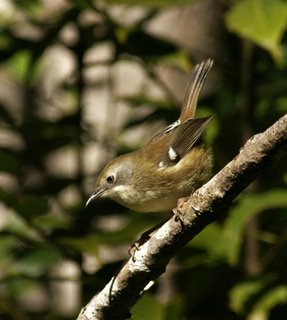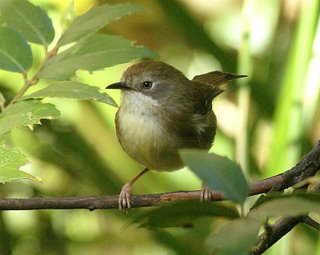 I've seen a good few Scrubtits over the years, but I have to confess that I've rarely spent much time actually watching them going about their business. Having photographed all the other Tasmanian endemics, I set about trying for the Scrubtit. Scrubtits spend much of their time on the vertical sides of moss and lichen covered trees, in deep shade rarely suitable for photography. The habitat is temperate rain forest, with scattered trees ferns. It's damp and dingy. I spent a good number of hours and made several trips to get even the shots you see here. It was interesting to watch Tasmanian Thornbills, Tasmanian Scrubwrens and Scrubtits as they fed around me, in a relatively clear area that I thought had some likeliehood of producing results. All 3 fed at different levels often in close proximity of one another. The Scrubwrens fed largely on the floor of the forest, often among fallen and rotting vegetation. The Thornbills were leaf gleaning and the Scrubtits
I've seen a good few Scrubtits over the years, but I have to confess that I've rarely spent much time actually watching them going about their business. Having photographed all the other Tasmanian endemics, I set about trying for the Scrubtit. Scrubtits spend much of their time on the vertical sides of moss and lichen covered trees, in deep shade rarely suitable for photography. The habitat is temperate rain forest, with scattered trees ferns. It's damp and dingy. I spent a good number of hours and made several trips to get even the shots you see here. It was interesting to watch Tasmanian Thornbills, Tasmanian Scrubwrens and Scrubtits as they fed around me, in a relatively clear area that I thought had some likeliehood of producing results. All 3 fed at different levels often in close proximity of one another. The Scrubwrens fed largely on the floor of the forest, often among fallen and rotting vegetation. The Thornbills were leaf gleaning and the Scrubtits were, as mentioned, feediing on insects among the moss and lichens on the trunks of trees.
were, as mentioned, feediing on insects among the moss and lichens on the trunks of trees.All three species were surprisingly tolerant of my presence, although I was in deep shade and reasonably camouflaged. The Scrubwrens and Thornbills came within a metre or less of me, but I wasn't so lucky with the Scrubtits! On several occasions all 3 species quite suddenly and quietly vanished, and it took me some time to work out why. While looking around I realised I was being watched! From behind the trunk of a tree, I noticed the unmistakea
 ble head of a Black Currawong eyeing me off, then taking flight as I moved. Several Currawongs had been calling from high in the tree canopy, but had silently descended. From these interactions, I suspect that the young of these three small species, may form part of the Currrawongs diet at this time of year. Few other birds were utilising this habitat, only the occasional Pink Robin and overhead, small groups of Strong-billed Honeyeaters, noisily pulling bark off as they searched for insects. Despite the long vigils, I count myself fortunate to have spent that time almost exclusively among Tasmanian endemic birds.
ble head of a Black Currawong eyeing me off, then taking flight as I moved. Several Currawongs had been calling from high in the tree canopy, but had silently descended. From these interactions, I suspect that the young of these three small species, may form part of the Currrawongs diet at this time of year. Few other birds were utilising this habitat, only the occasional Pink Robin and overhead, small groups of Strong-billed Honeyeaters, noisily pulling bark off as they searched for insects. Despite the long vigils, I count myself fortunate to have spent that time almost exclusively among Tasmanian endemic birds.
6 comments:
Worth the wait, beaut pictures and description.
Alan,
I would say that, given the usual habitat, you've done very well with these shots. As you say, deep shade and constant movement make these really tough birds to get ANY shots of. What I seem to get most when trying for shots of all three of these endemics is leeches!
I forgot to mention the leeches! It's interesting to consider that these 3 endemics have probably co-existed in this habitat for some thousands of years. If it wasn't for the occasional distant sound of passing traffic, you might feel this is probably as close as you can get to time travel!
Were these guys in one of the fern gullies on the moountain? I ask partly as a means of 'sussing' out good, quickly-accessible spots to 'tick' these three endemics for January's "Great Tassie Twitch". We have a few spots in mind to try for them, but are always on the lookout for more possible locations.
I think this information might be classified in the circumstances! Sorry to tell you, but they were taken in the Wielangta Forest. I think a trip between Marion Bay and Triabunna, with a couple of stops in the Wielangta Forest, could be very productive for twitchers.
Ah Yes! Sandspit River and environs is one of the spots we are considering for the Twitchathon, especially of we can't pick up these species and Pink Robin elsewhere. Ferntree and Neika are other likely spots where we've come across most of them, and a few of them usually turn up at Snug Falls, too.
Post a Comment